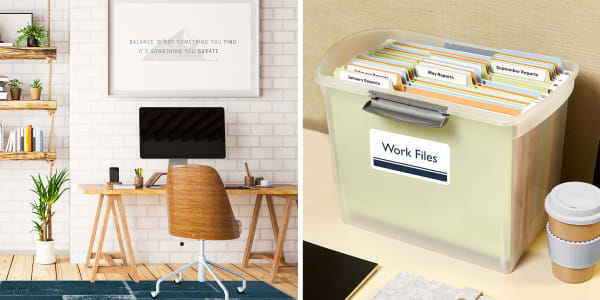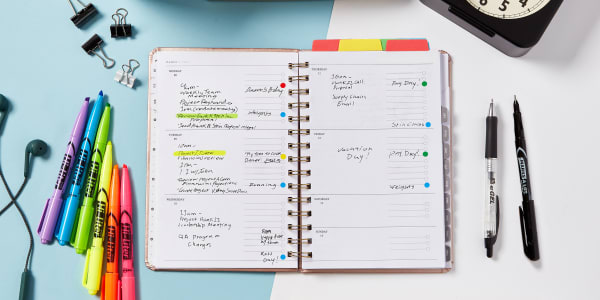5 WFH Tips to Help Your Brain Switch Out of “Work Mode”
Boundaries when working from home are good for your health and productivity
Whether you’re in-office or working from home, creating a healthy work-life balance is important. In fact, your brain actually needs downtime, which can help boost your mood, performance and ability to pay attention.
However, when your workplace is also your home, it can be harder to give yourself the space to turn off your brain, relax, recharge and come back refreshed the next day. With no commute and surrounded by the comforts of home, it can be tempting to work well past your allotted work-from-home time.
Start creating healthy work-from-home boundaries with 5 practical tips to help switch your brain out of “work mode” at the end of the day.

Use area rugs, artwork and other visual cues to create separation between areas for work and play. Organize your work supplies so you can put them away at the end of the day.
1) Create a dedicated space to work from home
Commuting can be stressful in and of itself, but the one thing it has going for it is that it’s a clear demarcation of the when the workday starts and ends. When you work from home, there is no built-in transition from working, to going about your daily life.
That being said, you can make your own transition by using physical separation to mimic leaving the office and help you get into the “off work” mindset. When you have a specific space for working from home, it’s easier to simply leave that space at the end of the workday.
A room you can turn into an office for working from home is ideal, but if you don’t have the luxury of extra space, a dedicated work-from-home desk can function the same way. Strong visual cues like a bold area rug, partitions or artwork makes a work space feel intentional and specific in a shared room.
Even if you come back later to check personal emails or whatnot, make a point of leaving your work-from home space at the end of the workday.
2) WFH organization tricks to stop work from taking over
Not everyone has the luxury of extra space for a home office, or even a desk totally dedicated to working from home. That’s okay. There are still ways to create separation between work and life
Keep your work from home supplies separate and easy to put away at the end of the day (or take with you if you transition between home and office). This includes laptops and devices.
Pay attention to paperwork. Keep it labeled and easy to put away out of sight. You don’t need work files distracting you while you’re trying to file your taxes or enjoy a Zoom hang with friends.
Mobilize your WFH supplies. If you don’t have a desk at all, for example sitting at the couch or kitchen table while working from home, make sure your work supplies are as mobile as you are. Try a rolling cart to store your supplies and work from home laptop. At the end of the day roll it somewhere out of sight.
3) Put away your WFH laptop after working hours
It’s so tempting, but don’t use your personal laptop (or devices) for work and vice versa. If you mix work-from-home laptops and devices with your personal ones, it’s just too hard to ignore emails, messages and other notifications that pop up after work hours.
Shut your work laptop and turn off devices during off hours. Especially on weekends. Unplug them and put them away in a drawer, cubby, in the laptop case– wherever you can. Get them out of sight, out of mind.
If you must use your personal laptop or devices while working from home, turn off notifications, or set them to snooze during non-work hours. Make sure to log out and close all work apps and programs at the end of the workday.

Use your planner to schedule physical activities to end your workday, as well as fun activities that act as incentives to put away your work.
4) Get physical: use motion to literally feel the difference
End work-from-home hours with physical activity so that you feel the contrast between work and play in your body and your mindset will follow. Exercise can also help manage stress, allowing you to relax and enjoy your personal time more.
Taking a walk is a fantastic way to switch the focus from working at home to living at home. Not only are you getting your body moving, but you’re also getting a change of scenery and new stimulus that redirects your brain from thoughts about work.
Another great option when working from home, is to schedule your regular workouts right after work hours. If you’re counting reps or following a routine, you’re not thinking about your inbox.
5) Plan hours for working from home and after-work activities
You’re already using your planner to be more productive while working. Don’t forget to schedule time to refresh and recharge yourself too. Not only can you schedule your end-of-day physical activities but also activities with friends or family to cap your work-from-home hours.
Making after-work plans with friends or family gives you a hard deadline to stop working because it’s harder to break plans with other people than with yourself. Whether you’re physically able to meet up, or meeting online, plans with another person are a commitment that’s not as easy to skip or push back.
Making plans with other people also gives you something fun to look forward to while working from home. It doesn’t have to be extravagant, it can be as simple as happy hour with friends, a video chat with family or meeting your buddies online to play your favorite MMO video game.
Organize your time, workspace and mind to create healthy work-from-home boundaries
Build boundaries into the structure of your work-from-home routine to help you switch off “work mode.” From physical boundaries such as designating workspace or getting your body moving after work, to visual cues such as putting work supplies “out of sight, out of mind.”
Whether you’re scheduling fun after-work activities in your planner or designating a work-from-home desk, home office or work supplies, organization is key. Get started now organizing your time and workspace and your mindset will follow.
Work-From-Home organizing supplies featured in this article
TrueBlock® 2" x 4" rectangle labels (by the package 8163 / by the sheet 94207)
TrueBlock white folder labels (by the package 8366 / by the sheet 94210)
Ultra-fine tip assorted Marks-A-Lot® permanent markers (9231)
Hi-Liter® assorted colors (23585)
Assorted color repositionable Utlra Tabs® (74768)
Assorted 1/4" color-coding dots (5795)